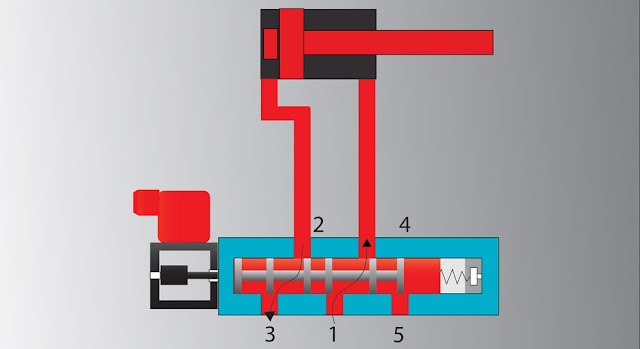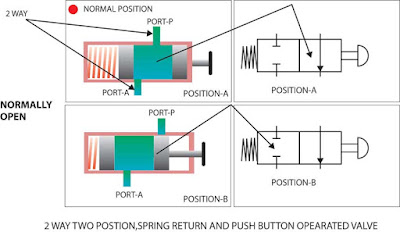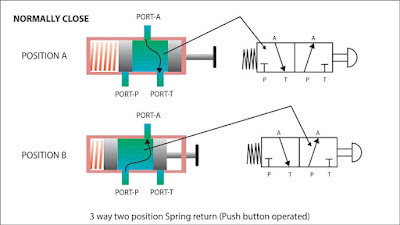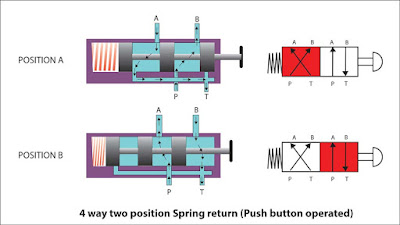Port and position of directional control valve.Today's lesson is all about all
about understanding the directional control valve port and position. What
is directional control valve port and position and how many port and position
stay in a single valve
Port and position of directional control valve types of directional control valve types of directional control valve solenoid control valve port and position valve position and way pneumatic valve diagram of directional control valve
What is directional valve port/way?
Way is the number of ports that is connected to the valve body in one position. Total number of flow path in a single position is called the port. Two way that means two port in a single position. Three way that means three port in a single position same as four way for four port in a single position.What is directional valve position?
The movement area of the spool is the position of the valve. The spool can stop in multiple position inside the valve and it depends on the actuated and de-actuated of the coils. When coil actuated then the spool moves and it changes his current position to another position.Basic hydraulic system Components of hydraulic system Hydraulic systems components- 2/2-Way directional control valve. (Normally open/Normally closed)- 2 Position 2 Way
- 3/2-Way directional control valve. (Normally open/Normally closed)- 2 Position 3 Way
- 4/2-Way directional control valve. 2 Position 4 way
- 4/3-Way directional control valve. 3 position 4 way
- 5/2-Way directional control valve. 2 Position 5 way. (For pneumatic valve)
-
5/3-Way directional control valve. 3 Position 5 way. (For pneumatic
valve)
2-way two position directional control valve (2/2-way Directional valve)
There we have two types of 2-way two position directional control valve. One of them is Normally open and other one is Normally close.For normally open
2-way valve has two port one of them is inlet and other one is outlet. For normally open position the pressure port and line port is open in resulting flow can passes through the valve. when coil is Energized/push switch is pressed then pressure port is closed and flow can't pass through the valve.
For normally close
This valve has also two port one is Inlet and other one is outlet. For normally close position the pressure port is open but line port is closed in resulting flow can't passes through the valve. when coil is Energized push switch is pressed then the line port is opened and flow can pass through the valve.
3-way two position directional control valve (3/2-way directional valve)
For normally open
There is a three port in 2/3-Way directional control vale called Pressure port, line port and tank port. For normally open position Flow enter to the P port and go to the line port and during this time tank port T is closed. After energized the coil, line port connected to the tank port T and flow starts going to tank and in this time P port is closed.
For normally close
Normally closed position directional control valve line port and tank port is connected with each other for free flow and then P port is closed. When coil is Energized/push switch is pressed then P port is connected to Line Port and then T port is getting closed.
4/2-way directional control solenoid valve (4-Way two position)
Four-way two position valve has two working position. When the valve position is A then Pressure port P is connected with port B and A port is connected with Port T. For this position Fluid flow will go to P to B and then fluid flow will return A to T port. Suppose you want to clamp a cylinder with this valve and the place where no need to change the direction continuously there can be use this valve. When you want to unclamp the actuator then just actuate the valve coil/press the push button for unclamping. When the valve position is B then pressure port P is connected with A and B port is connected with T port. For this position fluid flow will go to P to A and fluid flow will return from B to T Port. For this position actuator will be unclamp.
4/3-way valve directional control solenoid valve (3 position 4 way)
There is three working position in 4-way three position directional control valve. This valve is using to move the actuator in forward and reverse. When the spool in center position then P port is blocked that means fluid flow is stop. If spool moves to right side then A port will be connected with P port and B port will be connected with T port. If it happens cylinder will move forward. And when the spool moves to left then P port will be connected with B port and A port will be connected with T port. If it happens cylinder will move reverse. The diagram above is a close center directional valve diagram.
5/2-Way directional control valve. 2 Position 5 way. (For pneumatic valve)
There is 5 connecting port and 2 position in 5/2-Way directional control solenoid valve. Pressure port is indicating the number 1 and 2 & 4 is the actuator connecting port. 3 and 5 port are using as the exhaust port. Pressure port will direct work to retract the cylinder. When valve coil will be actuate then the cylinder will be extend. If coil is deactuate then the cylinder will be retract again. The main difference between 4/2-Way hydraulic directional control valve and 5/2-Way pneumatic directional control valve is the exhausting port. In hydraulic directional control valve has single exhausting port and in pneumatic directional control valve has two exhausting port. 5/2-Way valve = Two exhaust port & 4/2-Way valve = one Exhaust port. But both working principles is same.
5/3-Way directional control valve. 3 Position 5 way. (For pneumatic valve)
In picture 1 is pressure port, 2- & 4-cylinder connecting port, 3 & 5 is exhaust port. When the spool in center position then the pressure Port is blocked. In the left picture when the spool moves to left then Port 1 connected with port 4 then cylinder retract and Port 2 is connected with exhaust port 3.And when the spool moves to right (In right side picture) then Port 1 is connected with port 2 and then cylinder extend and Port 4 connected with exhaust port 5. This valve normal position is center position. Using this valve the cylinder can lock any position of cylinder stroke. That means you can brake your cylinder in any position.
Port and position of directional control valve types of directional control valve types of directional control valve solenoid control valve port and position valve position and way pneumatic valve diagram of directional control valve










This is very interesting, what do other people think? เทคนิคบาคาร่าออนไลน์
ReplyDeletePost a Comment